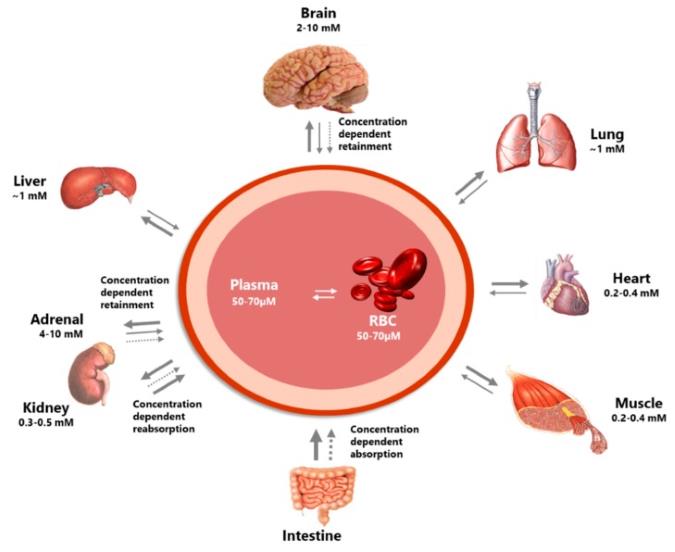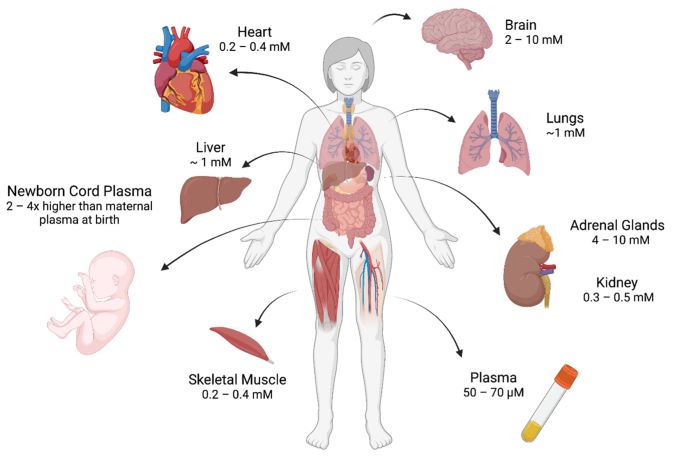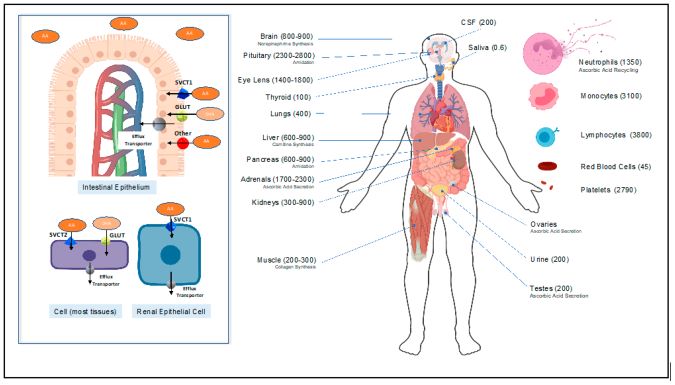
|

|

|

|
|
This article may be reprinted free of charge provided 1) that there is clear attribution to the Orthomolecular Medicine News Service, and 2) that both the OMNS free subscription link http://orthomolecular.org/subscribe.html and also the OMNS archive link http://orthomolecular.org/resources/omns/index.shtml are included. FOR IMMEDIATE RELEASE
IV Pharmacological ascorbate: a Misunderstood Nutripharmacologic Medical Therapy
Editorial by Juan Manuel Martinez Mendez, MD.Email: info@drjuanmanuelmartinezm.com OMNS (December 12, 2023) The present minireview will address the following questions.
AbstractNutritional pharmacology is an old described field in Medicine but is now forgotten, the IV pharmacological ascorbate a nutripharmacological agent has been using in acute severe complaints for more than 70 years now, his unique positive pleiotropic effects in special a H2O2 massive production depending on ascorbate gives a tremendous aide for restoration for a vibrant healthy life to grateful patients and compassionated and joyful health care providers and support family members IntroductionNutritional pharmacology was already defined as early as 1980 by the Late Dr Gene A Spiller Ph D as "the link between the nutritional and pharmacological health sciences and the application of both to medicine, includes pharmacological use of nutrients and other compounds derived from foods (both in natural form or as chemically modified) Dr Jeffrey Bland Ph D retaking that issue wrote 28 years later a provocative statement "As the field of nutrigenomics and nutritional epigenomics advances, however, it is likely that the concepts of Garrod, Williams, Pauling, and Hoffer will be found to be correct when nutritional pharmacology is applied to the right patient with the right dose of the right nutrient" Intravenous Nutritional Medical TherapyEarly daysAs early as in 1943 Dr Fred Klenner MD attended a critical cyanotic patient with a pneumonia due to difficulties for taking a RX of lungs he decided to inject IM two grams of pharmacological ascorbate with a unexpected and favorable response, in three days the patient received more than fourteen grams with and excellent outcome, five years later he published a key paper presenting a new and different form of treatment for this type of virus infection which in 42 cases over a five-year period gave excellent results, then 10 years latter published his experience treating patients with oral, IM and IV administration of pharmacological ascorbate Medical Facts
Although we lost more than 40 million years ago the ability to produce ascorbic acid from glucose in the liver due to an epigenetic - genetic mutation, finally we synthetized it in 1933 it after the discover in 1928 Ascorbate in pharmacologic concentrations selectively generates ascorbate radical and hydrogen peroxide in extracellular fluid in vivo https://www.pnas.org/doi/full/10.1073/pnas.0702854104 Coker, Sharna J., Carlos C. Smith-Díaz, Rebecca M. Dyson, Margreet C. M. Vissers, and Mary J. Berry. 2022. "The Epigenetic Role of Vitamin C in Neurodevelopment" International Journal of Molecular Sciences 23, no. 3: 1208. https://doi.org/10.3390/ijms23031208 
Tissue Distribution of Vitamin C. https://www.mdpi.com/1422-0067/23/3/1208 
Ascorbic Acid (AA) and dehydroascorbic Acid (DHA) transporters (left). Concentration of AA and DHA in human organs and cells in uM (right). Kashiouris, Markos G., Michael L'Heureux, Casey A. Cable, Bernard J. Fisher, Stefan W. Leichtle, and Alpha A. Fowler. 2020. "The Emerging Role of Vitamin C as a Treatment for Sepsis" Nutrients 12, no. 2: 292. https://doi.org/10.3390/nu12020292 With IV nutritional pharmacologic medical therapy, the supplements are administered into the body through the veins. By this route of administration, such prodrugs agents in some cases, they avoid the metabolism in the intestine, bypassing it and being 100 % bioavailable One key aspect is to differentiate a micronutrient and a nutripharmacologic agent; beginning with small amounts turning into massive or megadoses with a differentiated actions and effects, for example vitamin C is an essential nutrient not synthetized by primates contrary to the majority of animals as a vitamin is less of a gram per day, more that this turns into a nutripharmacological agent per se, IV pharmacological ascorbate or high doses of vitamin C = HDVC, or High-dose intravenous Ascorbic Acid (HDIVAA), parenteral high-dose ascorbate This extraordinary and indispensable Pharmacological ascorbate agent in megadoses or orthomolecular fashion and IV infusion exerts a myriad of pleiotropic functions like: donor electron agent, a redox agent, a key antioxidant, a key pro-antioxidant, a competitive inhibitor, norepinephrine biosynthesis, dopamine biosynthesis, vasopressin biosynthesis, connective tissue maintenance, regulation of cellular gene expression in response to hypoxia and stress, connective tissue maintenance, carnitine biosynthesis, phagocytic cell function, inflammation: immune cell clearance, lymphocytic function, direct antimicrobial activity, inflammatory mediators, endothelial function, platelet function and thrombosis among other, but most important a key epigenetic modulation coenzymatic factor. Acts a multimodal coenzymatic factor, supportive, optimizing immune-response, ending properly a resoleomic response, preventing major complications, reducing suffering in patients and diminishes anxiety by health care providers and gives an extraordinary tool and resource in complicated (IUC) Besides of reduction of stay in hospitalization in IUC, and in IUC sepsis patients a substantial reduction death when possible, being a supra selective agent, that affects to out control cells, microorganisms, disturbed homeostasis, physiologic dysmetabolism, etc., helps to regain optimal health status without negative pleiotropic effects bringing joy, gratitude and wellness to both care provider and patient and support family members Pharmacological ascorbate as a pro-drug for hydrogen peroxide formation (H2O2)One crucial action that this nutripharmacological agent has is its behavior as a pro-drug for the massive formation of hydrogen peroxide, a messenger molecule with low molecular weight molecule is utilized in metabolic regulation in ways similar to diffusible gases such as NO, CO, or H2S, is a normal aerobic metabolite. It is produced in the liver, and metabolically in the mitochondria respiratory chain, H2O2 is under sophisticated fine control of peroxiredoxins and glutathione peroxidases with their backup systems as well as by catalase. H2O2 transport across membranes is facilitated by aquaporins, a major source of hydrogen peroxide comes from the dismutation of the superoxide anion radical, there are several types of superoxide source among are NAD(P)H oxidases are prominent, operating under the control of growth factors and cytokines Activated monocytes or macrophages release superoxide and neutrophils and eosinophils utilize oxidants in antibacterial defense (oxidative burst), H2O2, as the product of pharmacologic ascorbate concentrations, has potential therapeutic uses in addition to cancer treatment, especially in infections. H2O2 is a potent mammalian antimicrobial defense mechanism H2O2 as a versatile and innocuous oxygen metabolite functioning in redox signaling. Major processes including proliferation, differentiation, tissue repair, inflammation, circadian rhythm, and aging use this low molecular weight oxygen metabolite as signaling compound. In acute or chronic challenging ailments, the extraordinary production of H2O2 via pharmacological massive doses of IV sodium ascorbate is of a paramount of importance being a central part of the metabolic contra response to either virus, bacterias, mycobacterias or stem cancer cells, the natural biologic and regulatory response in healthy individuals must be resembled and extra optimized with huge amounts of H2O2 DOSAGE SUGGESTIONSThe requirements of vitamin C depend not only on weight but also on metabolic activity, bodyweight, and nutritional status, absorption, etc., but the depending of the clinical status demands and status of the patient it will need more or less pharmacological ascorbate, ALA (alfa lipoic acid) NAC or n-acetyl cysteine, amino acids, and trace minerals among other nutripharmacological agents The author had made a simple but effective acute in viral aliments, dosage of pharmacological ascorbate depending of clinical status and case Outpatients 25 - 50 g per-day Hospitalized non-critical patients 50 g - 90 g per day ICU patients 1,5 grams/ kg of body weight, need 100 g or more per day q6h A consensus of several clinicians and researchers had published a more detailed version of a pertinent dosage was published this year: [Interpretation Miranda-Massari et al (2022) Aproposed Guide for Interpretation of Plasma Ascorbate Concentrations J Orthomol Med 37(1)] CONCLUSIONSThere are sufficient evidence of the key role of nutripharmacological agents via IV in different clinical scenarios, in this brief revision I only focused in one of them, pharmacological ascorbate, we have to take it from foods or in supplements on a daily basis but in order to face from a compatible, compassionate, smart and wise mode to acute viral and severe conditions we must use it as a unique and irreplaceable positive pleiotropic massive agent empowering the total and complex physiological reactions to overcome such extremely critical conditions and with possible fatal outcomes if we don't have such primer resource for helping our like-minded people This is an invitation to gain the attention of health care providers to take in account this affordable, easy use, multimodal and precious agent within everyone's reach (Dr. Juan Manuel Martínez Méndez graduated in 1987 from Pontificia Universidad Javeriana located in Bogotá, Colombia. Although alternative medicine captured his attention prior to entering the University, it was only after he attended a seminar in 1992 that he really began intense research and study of this topic.The author's website is https://drjuanmanuelmartinezm.com/ ) ReferencesSpiller, G. A. (1981). Nutritional pharmacology / editor, Gene A. Spiller. A. R. Liss. Bland J. The future of nutritional pharmacology. Altern Ther Health Med. 2008 Sep-Oct;14(5):12-4. PMID: 18780579 . Virus Pneumonia and its Treatment with Vitamin C Dr. Frederick Klenner MD Reidsville, North Carolina Southern Medicine & Surgery, Volume 110, February, 1948, Number 2, pp. 36-38, 46 Fred R. Klenner, M.D., Reidsville, N.C. Journal of Applied Nutrition, 1953, Vol. 6, pp. 274-278 Renner O, Burkard M, Michels H, Vollbracht C, Sinnberg T, Venturelli S. Parenteral high-dose ascorbate - A possible approach for the treatment of glioblastoma (Review). Int J Oncol. 2021 Jun;58(6):35. doi: 10.3892/ijo.2021.5215. Epub 2021 May 6. PMID: 33955499; PMCID: PMC8104923. Pleiotropic physiologic functions of vitamin C. Kashiouris, M.G.; L'Heureux, M.; Cable, C.A.; Fisher, B.J.; Leichtle, S.W.; Fowler, A.A. The Emerging Role of Vitamin C as a Treatment for Sepsis. Nutrients 2020, 12, 292. https://doi.org/10.3390/nu12020292 Table 1. Boretti A, Banik BK. Intravenous vitamin C for reduction of cytokines storm in acute respiratory distress syndrome. PharmaNutrition. 2020;12:100190. doi:10.1016/j.phanu.2020.100190, and non-complicated hospitalized and home patients Griendling KK, Sorescu D, Ushio-Fukai M. NAD(P)H oxidase: role in cardiovascular biology and disease. Circ Res. 2000 Mar 17;86(5):494-501. doi: 10.1161/01.res.86.5.494. PMID: 10720409. Babior B. M., Kipnes R. S., Curnutte J. T. (1973) Biological defense mechanisms. The production by leukocytes of superoxide, a potential bactericidal agent. J. Clin. Invest. 52, 741-744 Sies H. Role of metabolic H2O2 generation: redox signaling and oxidative stress. J Biol Chem. 2014 Mar 28;289(13):8735-41. doi: 10.1074/jbc.R113.544635. Epub 2014 Feb 10. PMID: 24515117; PMCID: PMC3979367 Massive doses of vitamin C and the virus diseases. South Med Surg. 1951 Apr;113(4):101-7. Zenglin Pei, Kang Wu, Zehuan Li, Chaoqun Li, Ling Zeng, Feng Li, Ning Pei, Hongmei Liu, Shu-lin Zhang, Yan-zheng Song, Xiaoyan Zhang, Jianqing Xu, Xiao-yong Fan, Jin Wang, Pharmacologic ascorbate as a pro-drug for hydrogen peroxide release to kill mycobacteria, Biomedicine & Pharmacotherapy, Volume 109, 2019, Pages 2119-2127 Chen Q, Espey MG, Krishna MC, Mitchell JB, Corpe CP, Buettner GR, Shacter E, Levine M. Pharmacologic ascorbic acid concentrations selectively kill cancer cells: action as a pro-drug to deliver hydrogen peroxide to tissues. Proc Natl Acad Sci U S A. 2005 Sep 20;102(38):13604-9. doi: 10.1073/pnas.0506390102. Epub 2005 Sep 12. PMID: 16157892; PMCID: PMC1224653. Pleiner J, Mittermayer F, Schaller G, MacAllister RJ, Wolzt M. High doses of vitamin C reverse Escherichia coli endotoxin-induced hyporeactivity to acetylcholine in the human forearm. Circulation. 2002 Sep 17;106(12):1460-4. doi: 10.1161/01.cir.0000030184.70207.ff. PMID: 12234948. González MJ, Miranda-Massari JR, Mora EM, et al. Orthomolecular Oncology Review: Ascorbic Acid and Cancer 25 Years Later. Integrative Cancer Therapies. March 2005:32-44. Kaya F, Belin S, Diamantidis G, Fontes M. Ascorbic acid is a regulator of the intracellular cAMP concentration: old molecule, new functions? FEBS Lett. 2008 Oct 29;582(25-26):3614-8. Prieto Gratacós E and Laguzzi M (2020) Pharmacokinetics of Six-Carbon Analogues of L-Glucose in Tumour-Bearing Humans (Series I: Ascorbate). J Oncol Res Ther 5: 10100. DOI: 10.29011/2574-710X.010100 Carpenter KJ. The discovery of vitamin C. Ann Nutr Metab. 2012;61(3):259-64. doi: 10.1159/000343121. Epub 2012 Nov 26. PMID: 23183299.) by Dr Albert Szent-Györgyi Nutritional Medicine is Orthomolecular MedicineOrthomolecular medicine uses safe, effective nutritional therapy to fight illness. For more information: http://www.orthomolecular.org Find a DoctorTo locate an orthomolecular physician near you: http://orthomolecular.org/resources/omns/v06n09.shtml The peer-reviewed Orthomolecular Medicine News Service is a non-profit and non-commercial informational resource. Editorial Review Board:
Albert G. B. Amoa, MB.Ch.B, Ph.D. (Ghana)
Comments and media contact: drsaul@doctoryourself.com OMNS welcomes but is unable to respond to individual reader emails. Reader comments become the property of OMNS and may or may not be used for publication. To Subscribe at no charge: http://www.orthomolecular.org/subscribe.html To Unsubscribe from this list: http://www.orthomolecular.org/unsubscribe.html |

This website is managed by Riordan Clinic
A Non-profit 501(c)(3) Medical, Research and Educational Organization
3100 North Hillside Avenue, Wichita, KS 67219 USA
Phone: 316-682-3100; Fax: 316-682-5054
© (Riordan Clinic) 2004 - 2024c
Information on Orthomolecular.org is provided for educational purposes only. It is not intended as medical advice.
Consult your orthomolecular health care professional for individual guidance on specific health problems.